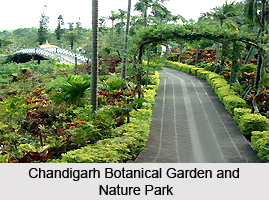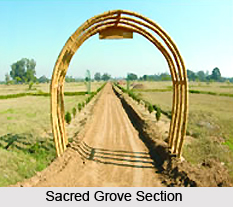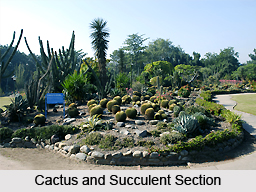 Botanical Garden and Nature Park of Chandigarh, has been set up with the aim of promoting research, conservation and education of floral heritage of the country. Located at the foothills of Shivaliks, Chandigarh enjoys a climate that supports the growth of a vast variety of flora. Thus, it serves as an excellent place for a botanical garden that conserves numerous species including the rare and endangered ones. It also promotes eco-tourism in Chandigarh.
Botanical Garden and Nature Park of Chandigarh, has been set up with the aim of promoting research, conservation and education of floral heritage of the country. Located at the foothills of Shivaliks, Chandigarh enjoys a climate that supports the growth of a vast variety of flora. Thus, it serves as an excellent place for a botanical garden that conserves numerous species including the rare and endangered ones. It also promotes eco-tourism in Chandigarh.
Chandigarh Botanical Garden and Nature Park was built by Chandigarh Administration near the village of Sarangpur. Spanning over an area of 176 acres, the garden is connected to Patiala-ki-Rao forest, a nature reserve, through a causeway. Lt. Gen. (Retd.) J.F.R. Jacob, the then Administrator, U.T. Chandigarh laid the foundation stone of the garden on 30th May, 2002. The project was guided by Gen. (Retd.) Dr. S. F. Rodrigues, the then Governor of Punjab and Administrator, U.T. Chandigarh; an avid nature lover. On 2nd January, 2007 the garden was inaugurated by him. It is one of the biggest gardens of this region and is divided into 15 botanical sections.
Medicinal Plants Garden
Medicinal plants garden covers about 40 acres of land and houses about 75 species of medicinal trees and 55 species of medicinal herbs, shrubs and climbers. Common species in this section include Harar, Neem, Maulsari, Lasura, Camphor, Sandalwood, Arjun, Ashwagandha, Kalmegh and many more.
 Bambusetum
Bambusetum
In this section 3 species of canes and 22 species of bamboos have been planted. It also includes a few species of ferns.
Ficus Grove
In this section, 18 species of Ficus have been planted. The section also hosts abundant free space for cultivation of more species in future.
Arboretum
Over 90 species of tress can be found in this section.
Ornamental/ Flowering Tree Section
This section comprises more than 35 species of ornamental plants such as Bauhinias, Cassias, Lagerstroemia, Acacias etc.
Pinetum
This section includes 12 coniferous species of plants.
Palmatum
20 species of cycads and palms have been planted in this section. Several species of pseudo-palms are also grown here.
Sacred Grove
This section has been structured according to a cosmic tree in which the main tree branches out in 11 sections. Each section is the representative of a specific religious Vatika namely Ram Vatika, Krishan Vatika, Guru-ke-Bagh Vatika, Kurani Vatika, Christian Vatika, Navgraha Vatika, Shiv Vatika, Vishnu Vatika, Brahma Vatika, Jain Vatika and Budh Vatika. Trees related to different religions are planted in different Vatikas.
 Cactus and Succulent Section
Cactus and Succulent Section
This section consists of over 100 varieties of Cactus and succulent plants, collected from various sources. The section is adorned with a beautiful water body and water channels. Apart from this, it also hosts a glass-house, poly-carb house and a poly-house.
Aquatic Plants Section
More than 30 species of aquatic plants are found in this section.
Rare Plants Section
This sections spans over an area of 3 acres and comprises rare species of Indian and foreign plants.
Tropical Rain Forest Section
This section has trees and plants especially belonging to the rain forests.
Bulbous Garden
A vast variety of bulbous plants are found in this section which covers an area of 2 acres.
Japanese Garden
This section is designed in Japanese fashion with plants specific to the region.
Nutrition Garden
This section consists of numerous fruit species which grow in tropical, sub tropical and temperate regions. More than 15 species of fruits grow in this region.
A Nature Interpretation Centre stands in the garden which exhibits artefacts related to the flora and wildlife. It serves the purpose of creating awareness in the mankind about forests, wildlife, medicinal plants, environment and nature. It also houses a conference hall where workshops and other activities pertaining to environmental education are conducted. A small library houses books related to environment and ecology. The garden has a long cycling track and two artificial lakes. The lakes serve the purpose of rainwater harvesting. In addition to the lake, a number of water bodies are also found here which helps in recharging underground water as well as beautify the garden. Two meditation huts have also been developed in the garden which comprises a poly-house and a green shade net-house.



















